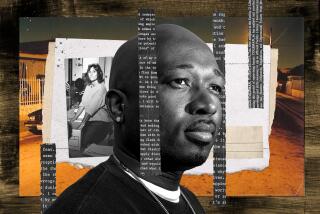A bloody-minded expert
- Share via
When Kimberlee Heale was a little girl growing up in Covina and San Diego, she used to ask her father, a firefighter, to describe traffic accidents. By the time she took a tour of the FBI Crime Lab as an eighth-grader, she knew that a career in forensics was for her.
“It was just the whole idea behind being able to put pieces of a puzzle together to figure out what somebody did,” she says. “It was pretty interesting to me.”
As a student at Cal State Fullerton, Heale majored in criminal justice with a concentration in forensic technology, and for the past nine years, she’s worked as a crime scene investigator for the sheriff’s department, first in San Diego and then in Orange County. She doesn’t carry a gun, and she’s had her share of harrowing encounters with suspects at crime scenes.
But these days, her job has a lighter side too: She serves as a consultant on Showtime’s Em- my-nominated series “Dexter.” Lately, she’s been reading scripts for accuracy, going on set for big investigation scenes and explaining DNA terms and technology to the cast and crew of the show, which is now in its third season.
Paper or plastic?: Whereas most procedurals portray evidence being stored in plastic bags, Heale suggested something different for “Dexter.” “Plastic is a big no-no,” she says. “With plastic, it will actually trap air inside. Over time, if it’s not properly stored, there will be degradation done to the DNA where it starts to break down. Brown paper bags or Manila envelopes are the most common things that we’ll use to collect and put our evidence in. And then if it’s any type of bodily fluid on something, you definitely want to store that frozen. At the crime lab, we have huge freezers. If it’s ever a murder trial, we have to keep that until the person’s actually -- if they get the death penalty -- executed, or they die of natural causes. Because any time with the appeals, evidence may have to be looked at again.”
Blood simple: Heale also advises on bloodstain interpretation. “There are different things that we look at that will actually allow us to determine and help reconstruct what occurred during the crime,” she explains. “A swipe will be something where the blood was already put down, like it’s already on the wall, and somebody walks by it and touches it. It’s going to create a different pattern when someone actually has something on their hands and then touches a wall [creating a smear]. [With] high velocity impact, you can tell because of the type of pattern, what type of weapon was used. What we call arterial spurtings are commonly mistaken for high velocity. And that’s basically when the jugular is injured, or someone is coughing, and they start spitting up blood. It can look pretty similar to velocity. So that’s a little tricky at times.”
Mug shots: Since Dexter always has to look good on the job, he can’t follow protocol exactly. “DNA is such a big thing in our field right now as far as evidence, and it’s so sensitive,” says Heale. “Sometimes, Dexter the character, he may be wearing what we call a particle mask or a death mask to eliminate the chance of cross contamination with his DNA over evidence. And if he has speaking lines, of course, he’s not going to be able to wear that and actually say his lines. So there’s some things where it’s not quite as accurate.”
Smooth criminal: According to Heale, one thing “Dexter” really gets right is that investigators have to think like criminals to catch criminals. “For the sheriff’s department, you have to work in the jails for a period of time before you go out into patrol,” she says. “And that’s to actually have you have a better understanding of the way criminals and suspects think. A lot of times as an investigator, you have to step into the suspect’s shoes to think, ‘OK, what area did they touch? What did they do when they were at this scene?’ It helps you better understand and also to look for the proper evidence at a crime scene.”
More to Read
The complete guide to home viewing
Get Screen Gab for everything about the TV shows and streaming movies everyone’s talking about.
You may occasionally receive promotional content from the Los Angeles Times.






